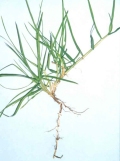
Kikuyu

Kikuyu
(High-resolution
image available)
NOTE: The information in this Agnote must be read in conjunction with Introduction to selecting and using pastures in NSW, which covers
information on areas of adaptation, sources of variability, species mixtures, and important issues related to animal health and the conservation of native vegetation.
| Pasture type and use | Perennial, spring/summer/autumn growing grass. Grazing, silage, hay, amenity (lawns, sporting fields, coast and inland irrigated). |
|---|---|
| Area of adaptation | Coast, Hunter, Metropolitan, irrigated areas. |
| Min. average annual rainfall | 800 mm |
| Advantages |
|
| Disadvantages |
|
| Soil requirements | Medium to well-drained; high fertility. Highly tolerant of acid soil. |
| Varieties | Select varieties on the basis of propagation method and tolerance to kikuyu yellows.
|
| Sowing rates | Whittet: 1–4 kg/ha Common: 1 cutting (runner) per square metre. |
| Sowing time | Spring to early autumn, depending on district. |
| Companion species | Not compatible with other grasses. Italian ryegrass or oats often direct-drilled or surface-sown in autumn into suppressed kikuyu for year-round feed. White clover, Kenya clover (Far North Coast). |
| Inoculation | N/A |
| Major nutrient deficiencies | Nitrogen, phosphorus, potassium, sulfur. |
| Main insect pests | Army worms, sod web worms, african black beetle. |
| Main diseases | Kikuyu yellows, leaf spot. |
| Management | Graze to maximise leaf, minimise stem. Hard graze to 5 cm in height. If pasture height exceeds 15 cm, slash to 5 cm to remove stem and rank growth and to maintain quality.
Optimum quality coincides with the 4½ leaf stage of regrowth. Use adequate fertiliser, especially nitrogen, to promote quality growth for dairy production.Hard grazing helps maintain white clover with kikuyu. |
| Livestock disorders of particular note | Frequently hyperparathyroidism (‘big head’) in horses, occasionally nephrosis or hypocalcaemia in ruminants, due to oxalates. Occasionally nitrate poisoning.
Kikuyu poisoning — unusual disorder, but occurs sporadically in cattle, especially where rapid growth follows a protracted dry period. |
| Additional tips | Quality, rather than bulk, is the key to high animal production from kikuyu pastures. |
| Further information |
|
Acknowledgments
Advice on livestock health disorders was provided by Dr Chris Bourke, Principal Research Scientist, NSW Agriculture, Orange. His contribution is gratefully acknowledged.
Photo: Warren McDonald, Former Technical Specialist (Pastures), NSW Agriculture, Tamworth

